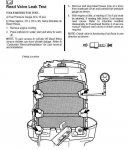hkeiner
Lieutenant Junior Grade
- Joined
- Oct 17, 2006
- Messages
- 1,055
How do you practically determine whether the bleed system check valves are functioning properly on a carbed motor?
I generally understand that a plugged bleed system check valve can cause poor running conditions and/or starve an internal bearing of needed lubrication. My Mercury shop manual's troubleshootng guide describes malfunctioning bleeder valves as one of the possible causes for poor idle, hesitation, poor accelleration, and other poor engine running conditions. However, this cause is lumped in with over a dozen other possible causes for these symptoms. I would like to test these valves in a way that is practical and effective. The Mercury shop manual does provide instruction on how to check bleeder valves (although somewhat vague - see below) but it seems to apply to checking these valves when the motor is disassembled or the valves are removed from the block. Is there a way to test these valves for failure without removal/disassembly? I figure a failure would be if the valve is "closed" at all times (i.e., plugged up) or "open" at all times (i.e., one way flow control is not working.)
For example,
a) Can one test by putting a hose on the end of a check valve while installed on the motor and blow/suck through the hose by mouth with the motor off?
b) Can one one test by using a pressure/vacuum gauge along with an air compressor to test each valve while installed on the motor and the motor off?
c) Can one test by attaching a vacuum/pressure gauge to a bleed line (using a T-connector and adaptors) and monitoring the pressure/vacuum in the line while the motor is running?
Any suggestion or thoughts on this would be appreciated.
Mercury Shop Manual
------------------------------------
Check operation of bleed system check valves in
reed block housing. If valves are working
properly, air can be drawn thru check valves “one
way” only. If air can pass thru a check valve both
ways, valve is not working properly and must be
replaced.
------------------------------------------
------------------------------------
Check operation of bleed system check valves in
reed block housing. If valves are working
properly, air can be drawn thru check valves “one
way” only. If air can pass thru a check valve both
ways, valve is not working properly and must be
replaced.
------------------------------------------





















